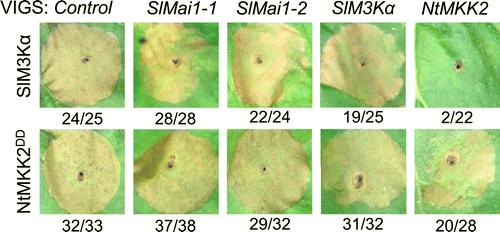Discovery of a new protein gives insight into a long-standing plant immunity mystery

Mai1 acts upstream of M3Kα and MKK2. Representative photographs of the cell death observed 5 days postagroinfiltration of the cell death elicitors SlM3Kα or constitutive-active NtMKK2DD into N. benthamiana leaves that were silenced using the indicated VIGS constructs. Credit: Robyn Roberts et al.
Tomatoes employ this method when they are invaded by a bacterial pathogen known as Pseudomonas syringae pv. tomato, which causes speck disease.
Scientists understand how the tomato recognizes this pathogen and know many of the plant proteins that are involved in the signaling cascade, but until recently they did not know what linked these two processes, a mystery that has been around for decades.
In a recent paper published in Molecular Plant-Microbe Interactions, scientists introduce a protein, called Mai1, that plays a role in this missing link.
They found that when they muted the expression of Mai1, the plants could no longer defend themselves against pathogens through the cell death response. As a result, these plants were more susceptible to bacterial infection.
They also found that Mai1 directly interacts with a protein at the top of the signaling cascade and upregulates its activity, suggesting that Mai1 plays a key role in activating the cascade.
“Our research suggests that Mai1 has a central role in immunity that likely can not be substituted by other proteins,” according to first author Robyn Roberts.
“Not only does this work give us better insight into how plants defend themselves on the molecular level, but this work reveals a key protein that is broadly involved in immunity. It is possible that Mai1 could serve as a target for crop improvement in the future.”
This research also showed that the muting of Mai1 stunted the plants, leaving them with brittle leaves and heightened sensitivity to mild stress, including pesticide application. This further shows the importance of Mai1, suggesting that the protein might also be involved in both immunity and plant growth and development.
###
For additional details, read “Mai1 Protein Acts Between Host Recognition of Pathogen Effectors and Mitogen-Activated Protein Kinase Signaling” published in the November issue of Molecular Plant-Microbe Interactions.
Media Contact
More Information:
http://dx.doi.org/10.1094/MPMI-05-19-0121-RAll latest news from the category: Life Sciences and Chemistry
Articles and reports from the Life Sciences and chemistry area deal with applied and basic research into modern biology, chemistry and human medicine.
Valuable information can be found on a range of life sciences fields including bacteriology, biochemistry, bionics, bioinformatics, biophysics, biotechnology, genetics, geobotany, human biology, marine biology, microbiology, molecular biology, cellular biology, zoology, bioinorganic chemistry, microchemistry and environmental chemistry.
Newest articles

Combatting disruptive ‘noise’ in quantum communication
In a significant milestone for quantum communication technology, an experiment has demonstrated how networks can be leveraged to combat disruptive ‘noise’ in quantum communications. The international effort led by researchers…

Stretchable quantum dot display
Intrinsically stretchable quantum dot-based light-emitting diodes achieved record-breaking performance. A team of South Korean scientists led by Professor KIM Dae-Hyeong of the Center for Nanoparticle Research within the Institute for…

Internet can achieve quantum speed with light saved as sound
Researchers at the University of Copenhagen’s Niels Bohr Institute have developed a new way to create quantum memory: A small drum can store data sent with light in its sonic…





















